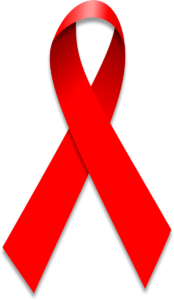 1980 – The Old Crow on Market Street, which opened in 1935, closes. Though it claims to have been the oldest gay bar in the City at the time, the Gangway, which opened in 1910 and remains open today, makes a strong claim to that honor.
1980 – The Old Crow on Market Street, which opened in 1935, closes. Though it claims to have been the oldest gay bar in the City at the time, the Gangway, which opened in 1910 and remains open today, makes a strong claim to that honor.- April 24, 1980 – San Francisco resident Ken Horne is the first person in the United States to officially be recognized to have a disease that would later be named Acquired Immune Deficiency Syndrome (AIDS), although research would later link previous mysterious deaths dating back to the 1950s in Africa and and 1960s in the U.S. to the disease.
- October 1980 – The Sisters of Perpetual Indulgence hold their first fundraiser, a bingo game and salsa dance. The event is a success, aided in part by a positive mention in Herb Caen’s column in the San Francisco Chronicle.
- 1981 – Mary C. Morgan becomes the first openly gay or lesbian judge in America when she is appointed by California Governor Jerry Brown to the San Francisco Municipal Court. The Midnight Sun moves from 506 Castro Street around the corner to 4067 Market Street and becomes what’s believed to be the country’s first gay video bar.
- November 1, 1981 – The Shanti Project organizes the first peer support group for San Franciscans diagnosed with what would later be called AIDS.
- December 1981 – AIDS “poster boy” Bobbi Campbell posts in the display window of Star Pharmacy on the corner of 18th and Castro notices about a “gay cancer” spreading through the City. Star Pharmacy is acquired by Walgreen’s in 1985.
- April 1, 1982 – The San Francisco AIDS Foundation is founded to respond to the AIDS crisis, opening their first office at 520 Castro Street.
- August 28 to September 2, 1982 – The first Gay Games, the world’s largest sporting and cultural event organized by, and specifically for lesbian, gay, bisexual, and transgender (LGBT) athletes, is held in San Francisco. Tina Turner performs at the opening ceremonies. The games were initially called the Gay Olympics but an injunction less than three weeks before the games began forced them to change the name.
- October 8, 1983 – The first AIDS Candlelight Vigil/Rally is held in San Francisco. It is the first time people with AIDS pubicly demonstrate in the City.
- May 1984 – The City finally settles with the Elephant Walk for $139,500 for damages caused by police during the White Night Riots.
- September 1984 – The first Folsom Street Fair is held. Originally intended to showcase the fairly industrial neighborhood as a viable place to live, the presence of leathermen due to the proximity of so many gay leather bars quickly turns it into what is now the largest leather and fetish event in the world.
- October 9, 1984 – Dr. Mervyn Silverman, San Francisco’s Public Health Director, closes 14 of San Francisco’s bathhouses in response to the AIDS crisis.
- July 1985 – The first Up Your Alley Fair is held at Ringold Alley.
- October 1, 1985 – Ruth Brinker, after discovering a neighbor with AIDS died of malnutrition, opens Project Open Hand to deliver meals to people with AIDS.
- November 17, 1985 – Cleve Jones conceives of the AIDS Memorial Quilt as a portable memorial of people who have died of AIDS.
- 1986 – Buzzby’s, once the most popular gay bar in the Polk, closes. FeBe’s, which helped establish the Miracle Mile along Folsom Street, also closes.
- October 1, 1986 – Cleve Jones creates the first panel of the AIDS Memorial Quilt in memory of his friend Marvin Feldman.
- 1987 – The Stud moves from Folsom Street to 9th and Harrison. Gays call it “the New Stud” for many years.
- June 1987 – The NAMES Project Foundation is formally created to manage and care for the ever-growing AIDS Memorial Quilt.
- July 1987 – More than 6,000 walkers raise $667,000 in the first AIDS Walk San Francisco in Golden Gate Park. The Up Your Alley Fair is moved to Dore Alley.
- November 1, 1988 – San Francisco forms what will become the largest needle exchange program in the country to help stop the spread of HIV among intravenous drug users.
- December 16, 1988 – Sylvester dies of AIDS-related complications in his Castro home on Collingwood Avenue.
- 1989 – Maud’s Study, which was the City’s oldest lesbian bar, closes.
- October 6, 1989 – In response to a small, peaceful ACT UP protest, more than 200 police officers descend on the Castro in riot gear in what is later called the Castro Sweep, declaring the neighborhood to be a no-assembly zone, and sweeping pedestrians off of the streets. More than 50 people are arrested, many of them clubbed and injured by police officers. The city ultimately pays $250,000 to settle two civil suits brought by victims of the police misconduct.
Through the 50s | The 1960s | The 1970s | The 1980s | The 1990s | The 2000s | The 2010s | 2020s+